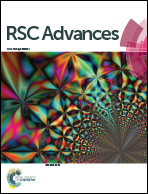The self-aggregation of fluorophore-triphenylamine nanostructures with tunable luminescent properties: the effect of acidity and rare earth ions†
Abstract
A D–π–A type triphenylamine derivative 3-(4-(diphenylamino)phenyl)acrylic acid (abbreviated as L) is designed, synthesized and characterized by single crystal X-ray diffraction analysis. The self-aggregation of L nanostructures in different acidity aqueous solutions and/or under the guidance of rare earth (RE) ions is studied, along with the corresponding optical properties. In strong acidic conditions, L molecules self-assemble to form two dimensional nanostructures. While in neutral aqueous solutions, L tends to form nanorods. In the strong alkali environment, nanofibers were obtained. Moreover, in acidic conditions, the existence of Tm3+ induces the L molecules to self-aggregate into nanoplates. Flower-like six branched structures are observed when Yb3+ is used. The changed morphology leads to tunable linear optical properties.


 Please wait while we load your content...
Please wait while we load your content...